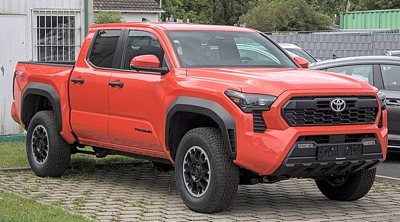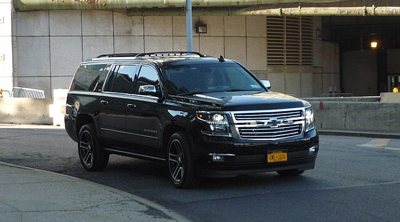Transporting furniture and other large items shouldn't be a challenge with the right vehicle. Of course there are a few factors you need to consider to make a good choice.
Let's take a look at some of those factors:
Frequency Of Use
 One of the biggest mistakes when buying a vehicle is thinking that something big will have to be hauled all the time. For this reason, some buyers often end up with a powerful truck they will rarely use to its capacity. If you're thinking of purchasing a vehicle that will be used for occasional hauling of large items, a mid to full-size truck should be more than enough.
One of the biggest mistakes when buying a vehicle is thinking that something big will have to be hauled all the time. For this reason, some buyers often end up with a powerful truck they will rarely use to its capacity. If you're thinking of purchasing a vehicle that will be used for occasional hauling of large items, a mid to full-size truck should be more than enough.
Ford F-150 or a Toyota Tacoma should perfectly fit the bill because the following reasons:
- Payload Capacity of Up to 1,500 lbs.
- Large Bed for Furniture and Other Large Items
- Additional Trailer Capacity for Larger Hauls
On the other hand, if you're looking for a more flexible vehicle that can be used not only for hauling, a full size SUV or a minivan should be more than enough.
Vehicles such as the Chevy Suburban or the Chrysler Pacifica offer an ideal solution for medium sized furniture and similarly sized items.
The 2024 Chevy Suburban has 144.7 cubic feet when seats are folded while the Chrysler Pacifica has 140.5 cubic feet of storage space when all seats are folded.
Axle Wheel Well Width
One very little but extremely important information any vehicle buyer should know when it comes to hauling is the axle wheel well width. It's a mouthful to pronounce but it's basically the measurement of space between the axle wheel well that protrudes on the vehicle bed. With this information, this will give you an idea on how large an item could be easily transported flat on the vehicle bed. For example, the Ford F-150 is measured at 50.6 inches while the Toyota Tacoma is measured at 44.7 inches.
 Protection From Outside Elements
Protection From Outside Elements
Transporting medium to large furniture from one place to another should not just be about getting the items to its intended destination. As much as possible, items of any size should be protected from any outside element that might destroy them on the way.
Other Factors Worth Considering
Other factors to consider include:
- Size and Weight of the Items: Consider the size and weight of items to be transported to determine the minimum vehicle size required.
- Payload Capacity: Make sure the vehicle's payload capacity can handle the weight of the items to be transported.
- Cargo Space: Consider the vehicle's cargo space.
- Towing Capacity: If towing a trailer, make sure the towing capacity can handle the trailer's weight and the items.
- Fuel Efficiency: Do not ignore fuel efficiency.
- Vehicle Type: Consider the type of vehicle that suits your needs. For example: truck, van, SUV, or trailer.
- Ramp or Liftgate: If you need to transport heavy or bulky items, consider a vehicle with a ramp or liftgate for easier loading.
- Parking and Storage: Consider the parking and storage space available for the vehicle.
Consider Renting As An Option
While the ability to haul items from time to time with your vehicle is a great idea, it's also impractical to purchase a truck or a full sized SUV if you're not sure when to use them for hauling. Renting a van or a truck specially made for hauling can be an economically smarter option.
A Look At Some Vehicle Sizes & Their Compatible Load Options
Here's a breakdown of vehicle sizes and their load options for transporting furniture or large items:
Compact SUVs and Hatchbacks
- Examples: Honda CR-V, Toyota RAV4, Subaru Outback.
- Cargo Space: 30-40 cubic feet with seats up, and up to 70 cubic feet with rear seats folded.
- Best For: Small furniture like chairs, coffee tables, or disassembled shelves.
Mid-Size SUVs and Minivans
- Examples: Chevy Suburban, Chrysler Pacifica, Toyota Highlander.
- Cargo Space:
Chevy Suburban: Up to 144.7 cubic feet with seats folded.
Chrysler Pacifica: Around 140.5 cubic feet with seats folded. - Best For: Medium-sized furniture like small couches, mattresses, or dressers.
Pickup Trucks
- Examples: Ford F-150, Toyota Tacoma, Chevrolet Silverado.
- Payload Capacity:
Ford F-150: Up to 3,325 lbs (depending on configuration).
Toyota Tacoma: Around 1,685 lbs. - Best For: Large furniture, appliances, or heavy items that can be secured in the open cargo bed.
Cargo Vans
- Examples: Ford Transit, Mercedes-Benz Sprinter, Ram ProMaster.
- Cargo Space:
Ford Transit: Up to 487 cubic feet (high-roof, extended-length model).
Mercedes-Benz Sprinter: Around 532 cubic feet (longest model). - Best For: Multiple large furniture pieces, such as sofas, dining tables, and wardrobes, with protection from weather.
Box Trucks
- Examples: U-Haul 15-ft Truck, Penske 16-ft Truck.
- Cargo Space:
U-Haul 15-ft Truck: Around 764 cubic feet.
Penske 16-ft Truck: Approximately 800 cubic feet. - Best For: Full-scale moves like transporting all the contents of a 2-3 bedroom home.
Conclusion
Ultimately finding the best vehicle for transporting furniture or large items depends on your needs and budget. Considering factors like frequency of use, payload capacity, and cargo space, can help make you make an informed choice.
